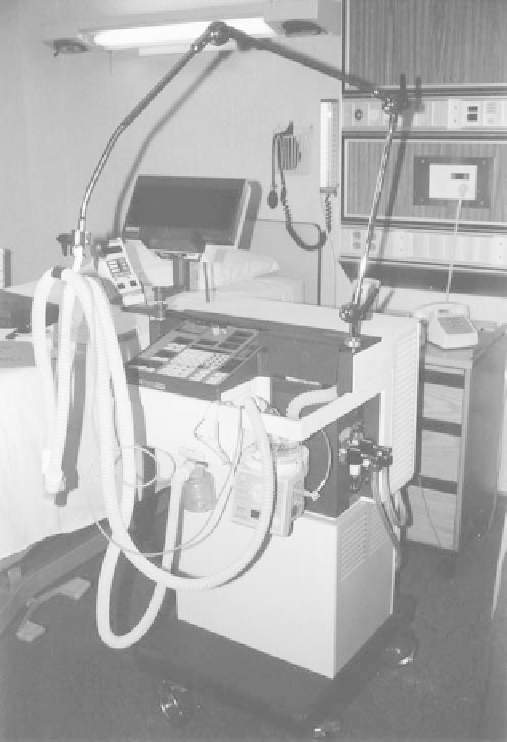Biomedical Engineering Reference
In-Depth Information
Oxygen is applied by facemask to raise saturation levels.
These are usual starting points, and many patients will
require not much more therapy than this throughout
their ICU stay. The patients are monitored, and the levels
of therapeutic support are correspondingly adjusted, until
the underlying disease process or condition is resolved.
This type of patient represents a sizable percentage of
the short-stay ICU population that is primarily being ob-
served and requires minimal or moderate support during
their stay. The more severely ill patients will undergo
more radical and invasive therapies. Following are major
categories of ICU therapeutic intervention.
Respiratory care: intubation, mechanical
ventilation
Respiratory failure can be described as the inadequacy of
the patient's intrinsic respiratory efforts to produce
normal blood oxygenation and carbon dioxide clearance,
as verified by arterial blood gas measurement. It can be
caused by a host of factors, including infection, trauma,
and paralysis. The primary consideration of mechanical
ventilation has been to restore the patient's blood gas
value to nominally normal levels. In spontaneous venti-
lation, the lungs inflate when negative pressure is created
in the thoracic cavity by the downward displacement of
the diaphragm. Until the mid-1950s, this was done with
devices such as the iron lung, a container that surrounded
the patient with his head protruding by way of an airtight
collar (M¨rch, 1985). This subjected the patient's body
to a negative pressure, relative to the outside air, allowing
the patient to inspire ambient air through his mouth as
the iron lung cycled. This form of ventilation placed little
stress on the patient's pulmonary system. He could eat,
drink, and talk because his airways were otherwise
unencumbered.
After the polio epidemics of the 1950s, positive-
pressure mechanical ventilation became more wide-
spread. In this mode, the lungs inflate when positive
pressure is generated by the ventilator, forcing the lungs
open and causing downward displacement of the
diaphragm. Most often, this is done by delivering
a volume of humidified, blended air and oxygen mixture
by way of an endotracheal tube. Modern mechanical
ventilators (see
Figure 4.2-3
) have a wide range of set-
tings over a range of pressure limits such as O
2
per-
centage, tidal volumes respiratory rates, and positive-end
expiratory pressure (PEEP) (Behbehani, 1995). This
type of technology has been in place for more than 35
years, with various improvements in machine size,
intelligence, display, modes of ventilation, interfacing,
and data collection. However, there is a danger, long
recognized, of ventilator-induced lung injury (VILI) or
ventilator-associated
Figure 4.2-3 Puritan-Bennett model 7200 ventilator.
indiscriminate use of positive-pressure mechanical ven-
tilators. Overdistension of the alveoli, either by excessive
pressures or volumes, can cause dangerous lung damage
especially in the presence of high-oxygen concentration.
This is often evidenced in the longer-term patient
requiring higher levels of respiratory support. In addi-
tion, injury to the lung can produce a cytokine cascade
effect that can cause damage to organs throughout the
rest of the body. One approach to alleviate this problem
is the use of permissive hypercapnia. Smaller tidal vol-
umes are used to prevent lung distension and high airway
pressure. This produces less CO
2
clearance, and the
blood pH will be lower (more acidic), but this method
can protect the lungs from permanent injury.
As an alternative, other ventilator technologies are
available. High-frequency jet ventilation (HFJV), high-
frequency positive-pressure ventilation (HFPPV), and
high-frequency oscillation (HFO) all limit the volume
and, hence, the pressure provided to the patient on each
breath by operating at supranormal respiratory rates
(Hamilton, 1988). HFJVand HFPPVoperate in the realm
of 100-200 breaths per minute, and HFO in the domain
pneumonia
(VAP)
with
the






